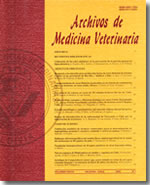Excretion and transmission study of the Chilean porcine reproductive and respiratory syndrome virus isolate by means of RT-nPCR and ELISA in experimentally inoculated animals and sentinels in contact
Main Article Content
Abstract
The excretion and transmission of PRRSV was studied through RT-nPCR in nasal secretion and serum samples, together with detection of antibodies by ELISA. Thirty pigs, of 3 weeks age, were used and they were randomly assigned into 6 groups. One group of pigs (G1) was inoculated intranasally with 2 ml and intramuscularly with 1 ml with the 2402 isolate in a concentration of 105.7 TCID50 per ml, and they were kept for 35 days in an isolation unit. Four groups (G2, G3, G4, G5) were used as susceptible and they were in contact with the inoculated pigs (G1). Group 1 showed that the Chilean PRRSV isolated induces a condition of viremia beginning at 3 days post infection (dpi), increasing at 7 dpi , and then declines until 35 dpi (P < 0.1). The virus was detected in the nasal swabs, from 3 dpi, increasing at 7 dpi, and remaining like that until 19 dpi. On the other hand, G2 had a 60% of viremic animals at 5 days post contact (dpc) and then 100% at 12 dpc; G3 showed a 80% of positive pigs at 5 dpc and 100% at 12 dpc; G4 had 100% of viremic pigs at 5 and 12 dpc; and finally, G5 showed only a 60% of positive animals at 12 dpc. The results suggest that the national isolate induces an early viremia and is excreted through nasal secretions; moreover, it induces sero-reaction in presence of viremia. It can be concluded that the national isolate of PRRSV was transmitted from G1 to the contact groups between 3 and 28 dpi, being this transmission more effective between 3 and 21 dpi.

